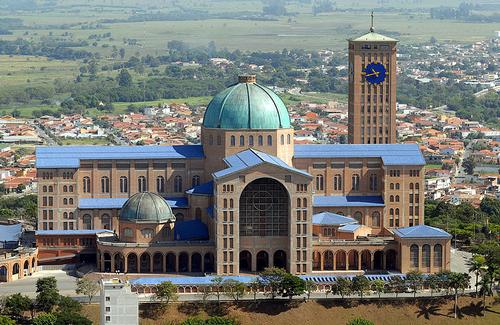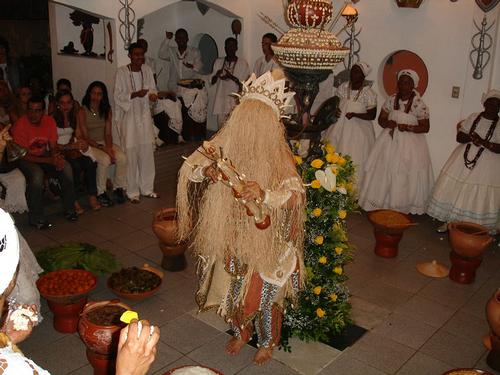BRAZIL
Religion

Religion

Cities in BRAZIL
| Rio de janeiro |
Religion
 Brazil Basilica of the National Shrine of Our Lady of AparecidaPhoto: Valter Campanato/ABr CC 3.0 Brazilië no changes
Brazil Basilica of the National Shrine of Our Lady of AparecidaPhoto: Valter Campanato/ABr CC 3.0 Brazilië no changes
Catholicism in the Portuguese colony of Brazil was different from that in the Spanish territories. The Spaniards were very strict in their teaching and the Indians, slaves and other immigrants actually had no choice: they had to become Catholic. The Portuguese were a little less firm in their doctrine and there was also ample room for elements from African religions.
Brazil now enjoys full religious freedom after the separation of church and state in 1946. This previously happened in 1890, but in 1934 the unit was restored.
The population was over 64% Roman Catholic in 2010 and Brazil is the largest Catholic country in the world. The population is also approximately 22% Protestant. The latter group experienced strong growth in the eighties and nineties of the twentieth century, such as the German Evangelical Church in the southern states. Furthermore, all kinds of Protestant societies and sects (together about 5% and non-believers about 8%), often from the United States, are gaining ground, such as Baptists, Lutherans, Anglicans, Evangelists, Presbyterians and Methodists. There are also Jews, Buddhists, Muslims, Shintoists, Baha'is and Mormons.
The number of Spiritualists is also very large and for many the boundaries between Catholicism and all kinds of popular religions are extremely vague.
In addition, "scientific spiritism", which goes back to the Frenchman Allan Kardec (= H.L. Denisard Rivail, 1803-1869), is very widespread, especially in the cities. Some Eastern religious influences are recognizable in this movement.
This mixture of Catholic and African influences (sincretismo) is fascinating and dates back to the time of slavery. Under the cover of Catholicism, the slaves continued to worship their own gods (orixás) and perform their own religious rituals. For example, the orixás were simply renamed Catholic saints, and the Portuguese had long believed that. There are about 500 orixas in total, but only six are found in all Afro-Brazilian religions. Some orixás are Oxalá, the central deity, Ogum (violence, power), Xangô (natural forces, fire and lightning), Oxossi (life, plants and animals) Oxum (lakes and rivers) and Iemanjá (sea and fertility).
 Brazil CandomblePhoto: Toluaye in the public domain
Brazil CandomblePhoto: Toluaye in the public domain
The most famous Afro-Brazilian religions are candomblé and umbanda. It is believed that the spirits of the dead and gods can positively and negatively affect people's lives. One comes into contact with a ghost or a dead person during a ceremony in which the believer becomes possessed. All this is usually done under the guidance of a priestess who is in contact with the gods, the "orixás". The ceremony is accompanied by the sound of gourd-shaped atabaque drums and the faithful walk and dance and sing African lyrics.
These religions originated in the northeast and from there spread across the rest of Brazil. Candomblé is the oldest Afro-Brazilian religion that still has strong African (Yoruba) influences and can be compared to some religions in Africa. The largest followers are located in the "black" state of Bahia, where more than a thousand temples are located. These temples are often ordinary houses. Candomblé has many names, depending on the state: in Amazon and Pará babassué, in Pernambuco and Alagos Xangô, in Rio Grande do Sul Pará or batuque en tambor in Maranhão.
The macumba, a bastardized form of the candomblé, developed in Rio de Janeiro. From the macumba arose again umbanda, a spiritistic variant of white magic that mainly takes place in the big cities. The number of followers is estimated to be over thirty million and they come from all walks of life. Quimbanda is considered by the Brazilians to be black magic, where witches sacrifice animals.
The Native American religions are based on assigning magical meanings to all kinds of objects and events. Ancestor worship is also important to the Indians. The shaman is the religious leader and medicine man. He performs rites that cure diseases or cast out devils. He often uses medicinal herbs from the jungle for this. Just like the Indian languages, the Indian religions are also under great pressure and are in danger of disappearing completely.
Sources
Bayer, M. / Brazilië
Gottmer/Becht
Bayer, M. / Brazilië : mensen, politiek, economie, cultuur
Koninklijk Instituut voor de Tropen/Novib
Bender, E. / Brazil
Chelsea House Publishers
Brazil
Apa Publications
Brazil
Lonely Planet
Brazilië
The Reader's Digest
Dekker, J. / Reishandboek Brazilië
Elmar
Heinrichs, A. / Brazil
Children's Press
CIA - World Factbook
BBC - Country Profiles
Copyright: Team The World of Info